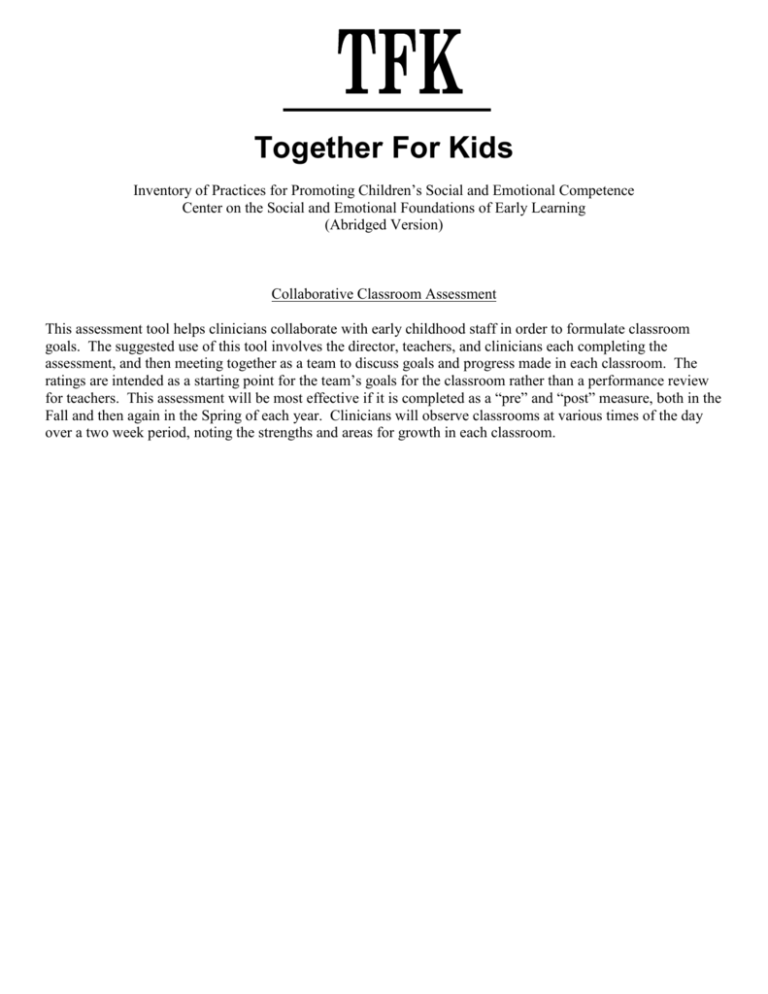Collaborative Classroom Assessment
advertisement

Together For Kids Inventory of Practices for Promoting Children’s Social and Emotional Competence Center on the Social and Emotional Foundations of Early Learning (Abridged Version) Collaborative Classroom Assessment This assessment tool helps clinicians collaborate with early childhood staff in order to formulate classroom goals. The suggested use of this tool involves the director, teachers, and clinicians each completing the assessment, and then meeting together as a team to discuss goals and progress made in each classroom. The ratings are intended as a starting point for the team’s goals for the classroom rather than a performance review for teachers. This assessment will be most effective if it is completed as a “pre” and “post” measure, both in the Fall and then again in the Spring of each year. Clinicians will observe classrooms at various times of the day over a two week period, noting the strengths and areas for growth in each classroom. Collaborative Classroom Assessment Teaching Team: ________________________ ________________________ ________________________ Please indicate Lead Teacher : ________________________ Agency: _____________________________________________________ Rate each item based on your current experiences Space - includes: Date: ___________ Seldom/Never 1 Sometimes 2 Consistently 3 Comments Seldom/Never 1 Sometimes 2 Consistently 3 Comments learning centers with clear boundaries fluid traffic pattern with no wide-open spaces structure and organization for seated activities adult supervision and monitoring (e.g., zone, man-to-man) Schedule - includes: schedule & routines: followed, appear to be known to children balance of teacher and child-directed activities balance of large, small, individual activity opportunities teacher-directed activities maximum 15 minutes Materials - are: adequate in number in all learning centers developmentally appropriate and interesting for range of children in room inclusive of children's preferences organized, well displayed prepared before children arrive accessible to children independently Transitions transitions between activities follow specific routines that are made clear to children children receive prompts for upcoming transitions prompts are varied as needed for individual children minimum time during the day is spent in transitions learning opportunities are a part of transitions (little "wait time") Tone of classroom children are actively engaged in productive activities children treat one another with respect teachers tell children what TO DO, rather than DON'T teachers enthusiastically notice and comment on appropriate behavior teachers respond more to positive than to negative behavior Teacher-child interaction - teachers: greet children by name on arrival and throughout day communicate on eye level join play to support/expand - leave leadership with child converse with children (initiating/responding) during routines and activities respond to children's ideas respond to children's feelings Giving directions - teachers: give directions in clear consistent manner individualize directions when needed for certain children check children's understanding of directions give choices and options when appropriate Teaching self-regulation Seldom/Never 1 Sometimes 2 Consistently 3 Comments rules are few in number and important (e.g., safety, respect) rules are clearly communicated to children rules are used to promote independence and selfregulation rules are stated using positive language rules are enforced consistently and fairly natural consequences are used for positive and negative behavior children are reinforced for following the rules teachers model emotion-regulation strategies Teaching emotional understanding children's emotions are validated - emotions are OK, but not all expressions are OK emotion signals (facial expressions, words) are described positive and negative feelings are acknowledged and labeled large/small group activities are used to talk about and teach children about emotions natural teaching opportunities are used to teach about emotions, emotional behavior, and acceptable ways to express emotions (own and others' emotions) Teaching positive behavior provide materials/activities that encourage cooperation and interaction provide opportunities for peer buddies monitor room/group and provide assistance or change activity when needed use descriptive language to notice what children are doing well teach strategies for initiating and responding to peers comment enthusiastically on positive peer interactions use peer models as examples teach strategies for problem solving and working together via large/small group activities use natural teaching opportunities to teach appropriate social behavior (e.g., problem solving) Team Member Signatures: ____________________________________________________________________________________________________________ ____________________________________________________________________________________________________________








